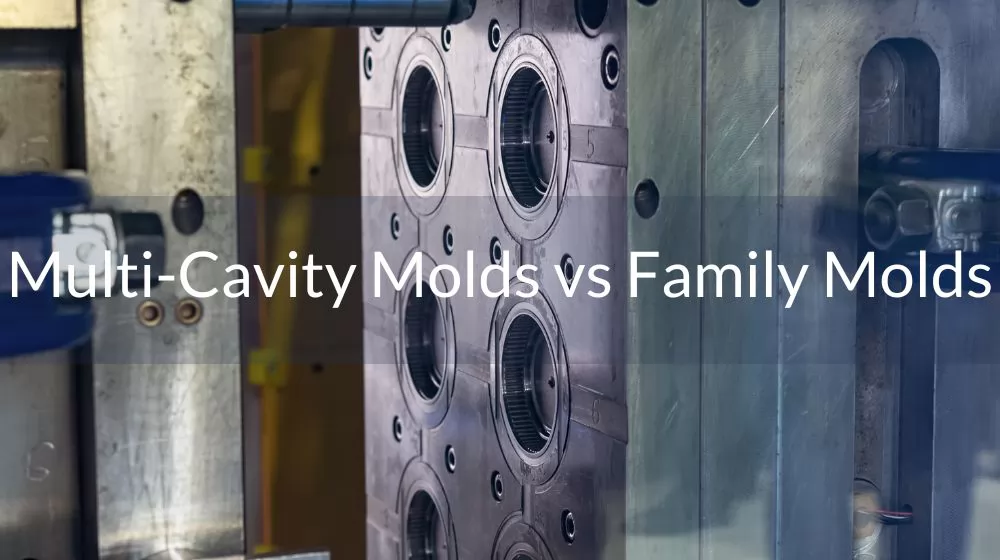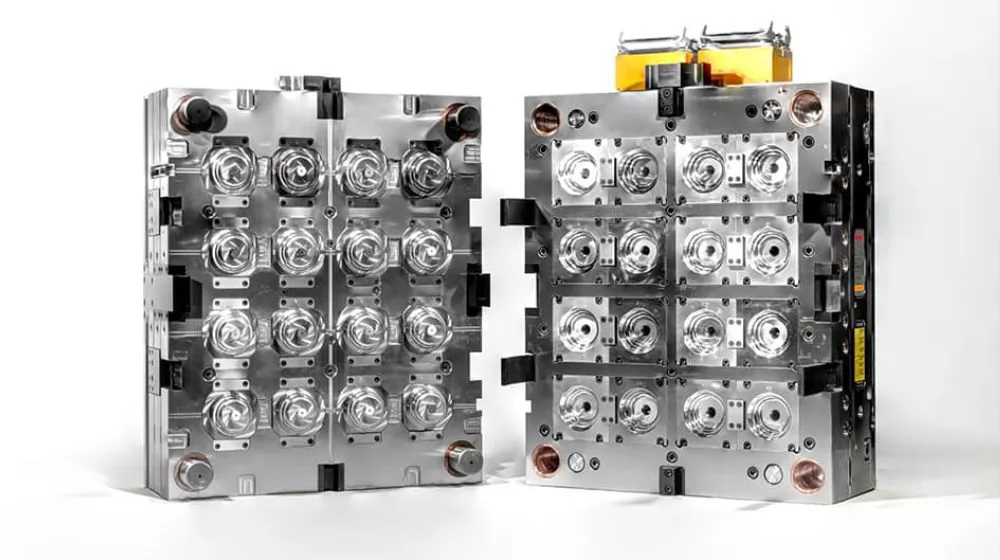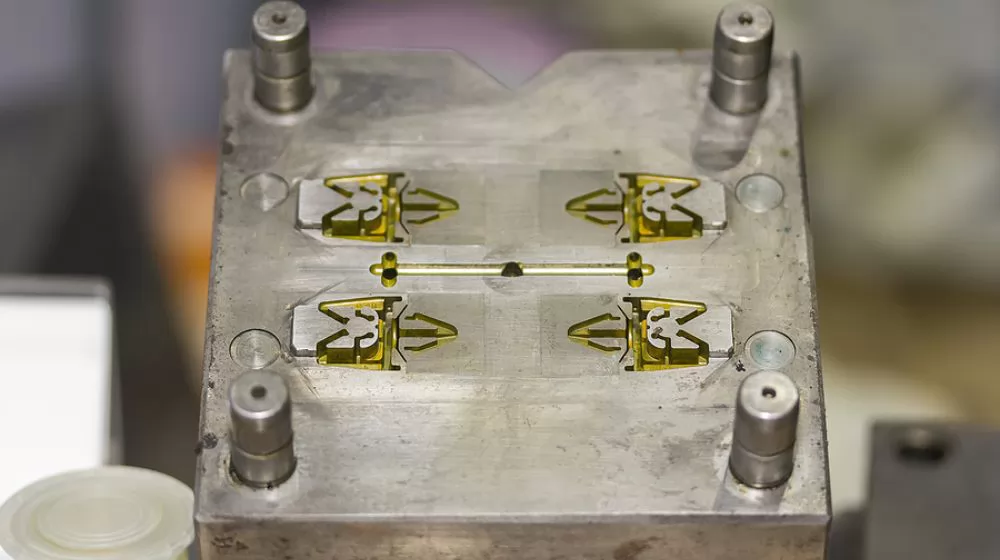
The injection molding process involves inserting plastic into a hollow mold cavity. The final product takes on the shape of the desired part. But what if your project requires multiple plastic parts? Designing and manufacturing multiple molds is expensive and time-consuming, which is where multi-cavity molds and series molds come into play. In this blog, we’ll discuss the differences between the two and how to decide which option best suits your needs.
Table of Contents
- Multi-cavity injection mold
- Family molds
- How do multi-cavity injection molds work?
- How do family molds work?
- Advantages of multi-cavity injection molds
- Benefits of family molds
- Disadvantages and prerequisites for multi-cavity and series molds
- Multi-cavity mold VS family mold
- Choosing the right manufacturer for family molds
- In conclusion
Multi-cavity injection mold
Multi-cavity molds have multiple cavities for the same part and produce multiple parts per production cycle. With shorter lead times per batch, the required number of parts can be completed faster using multi-cavity molds. This increases productivity and provides better yields for high-volume production.
Multi-cavity molds also allow you to use cycle time more efficiently and produce more parts with the same mold within an injection guarantee. At HingTung Group, our multi-cavity molds ensure you get quality parts while maintaining precision tolerances and optimizing cycle times.
Family molds
Family molds have multiple cavities cut into the mold, allowing multiple different parts of the same material to be formed in a single cycle. Each cavity typically forms a different part, making it ideal for prototype molds due to the fast molding cycle.
However, home molds are often unbalanced when filling because parts often have different shapes, which can lead to increased molding defects.
When multiple parts come out of the mold, more processing is required to separate the parts. This usually requires more manual labor since automation does not work well in the separation process.
Since home molds have a higher defect rate, they are generally less expensive than multi-cavity molds.
How do multi-cavity injection molds work?

A multi-cavity injection mold is a tool used for injection molding that has multiple molding cavities to produce multiple identical or different parts simultaneously. It works by creating multiple molding cavities in the mold, allowing the injection molding machine to produce multiple parts in a single cycle.
The working process of a multi-cavity injection mold is as follows:
Design Phase: In the design phase, engineers will determine the shape, size and injection molding process requirements of the product. They will then design the mold to include multiple molding cavities to produce multiple parts simultaneously.
Making the Mold: Once the design is complete, the mold making process begins. This involves using high-strength and wear-resistant materials to create the mold to ensure it can withstand high levels of use.
Installing the mold: After manufacturing is complete, the mold is installed on the injection molding machine. The structure of the mold allows multiple parts to be molded simultaneously in one injection molding cycle.
Injection Molding Process: During the injection molding process, plastic pellets are heated and injected into the mold. Since the mold has multiple molding cavities, it can form multiple parts at the same time.
Cooling and Solidification: Once the plastic fills the molding cavity in the mold, the mold cools, allowing the plastic to solidify. This ensures that the final part is shape and dimensionally stable.
Opening the mold and removing the parts: After cooling, the mold is opened, allowing the formed parts to be removed. Since the mold has multiple molding cavities, multiple parts can be taken out at the same time.
Repeat cycle: The entire process is repeated, allowing a large number of parts to be produced in a short period of time.
The advantage of a multi-cavity injection mold is that it improves production efficiency, reduces costs, and is suitable for mass production of the same or similar parts.
How do family molds work?
Serial injection molds are complex tools that operate through well-defined processes to produce multiple parts simultaneously. Here are some key points to understand how family molds work:
Mold Design: Designers carefully design a series of molds to accommodate multiple cavities or impressions in a single tool. Designers plan mold layouts to optimize the arrangement and spacing of cavities to ensure efficient production and consistent part quality.
Material Selection: We select the appropriate thermoplastic material based on the properties and requirements required to produce the part. Factors such as strength, flexibility, heat resistance and appearance are critical in material selection.
The injection molding process begins by heating a selected thermoplastic material to its melting point, forming a molten resin. We inject molten material into the mold cavity through a runner and gate system that distributes the material into each hole.
Cooling and Solidification: Once the molten material fills the cavity, it cools and solidifies. Cooling channels within the mold help regulate temperature and promote solidification. Proper cooling is critical to ensuring consistent part dimensions, minimizing warpage and promoting efficient cycle times.
Ejection of the part: After the material solidifies, we open the mold and eject the feature from the mold cavity. We can accomplish ejection using a variety of methods, including mechanical ejection systems, air injection or hydraulic ejector pins. We must prevent damage to parts during ejection.
Quality Control: Throughout the entire production cycle, we take steps to ensure that parts meet specified requirements. We closely monitor important factors such as temperature, pressure and cycle time. We also perform visual inspections and dimensional inspections.
Maintenance and Troubleshooting: Regular maintenance is necessary for optimal performance of your range of molds. This maintenance includes cleaning, lubrication and regular inspection for wear or damage. If problems arise during production, we may employ troubleshooting techniques to identify and resolve mold-related issues.
Advantages of multi-cavity injection molds
Multi-cavity molds contain multiple cavities of the same part. It is capable of producing a large number of parts per injection molding cycle, making it ideal for high-volume production. Some other notable benefits include:
Shorter lead times: Since multiple parts can be completed per cycle, quotas can be met faster.
Lower Mold Cost: A mold with four cavities is less expensive and has a lower cost of ownership than creating four separate molds.
Lower Part Price: Multi-cavity molds require less overall labor and processing time, resulting in lower price per part.
Order scalability: It is difficult to meet the demand for a million parts with a single-cavity mold. Multi-cavity molds allow you to place large orders and have them fulfilled in a timely manner.
Multi-cavity molds are ideal for companies that need to produce large quantities of parts in a short period of time.
Benefits of family molds
Although a multi-mold also contains multiple cavities, the resulting parts are similar in size but different in design. For example, if your part requires two different parts with nearly identical dimensions, you can use this tool to produce them simultaneously. It has the same advantages as a multi-cavity mold, but with some additional advantages:
Easier ordering: Placing an order for a product that contains multiple parts can be complicated. However, a mold that contains the appropriate number of parts to complete the product can simplify the process.
Low-volume order potential: Series injection molds are cost-effective for low-volume orders because you don’t need to run different molds through multiple cycles to complete the product.
Ideal for prototyping: Pre-production costs can be reduced since the product can be fully assembled using just one series of mold prototypes.
Since this is a complex tool, it is wise to work with the supplier early on to ensure the mold runs efficiently and accurately.
Disadvantages and prerequisites for multi-cavity and series molds

The craftsmanship of these two molds is very similar, making them both have advantages and disadvantages in many aspects. For example, while they will save you money in the long run, they require a higher initial investment because their complexity requires longer development time from the moldmaker. They also require your parts to meet similar standards, including:
The plastics must be of the same material and color: different plastics or colors cannot be used during the injection molding process of a single multi-cavity or series mold.
Parts must be of similar size and volume: Since all cavities are filled at the same time, part sizes or shapes that are different can result in underfill or flash molding defects.
Runner type: The number of parts in the mold can determine the type of runner you use. If the mold contains a large number of parts, a hot runner is required.
However, series molds have some disadvantages compared to multi-cavity molds. Due to the complexity of the mold, its defect rate is higher due to the imbalance of different parts, and because multi-purpose molds have multiple different parts in the same mold, they require extra careful handling.
Multi-cavity mold VS family mold
| Features | Multi-cavity Mold | Family Mold |
|---|---|---|
| Number of molding cavities | With multiple molding cavities, multiple identical or different parts can be produced simultaneously. | A molding cavity that contains multiple parts within a mold, usually used to produce different parts of a product. |
| Applicability | Suitable for mass production of identical or similar parts. | Suitable for producing different parts of a product, especially products that are assembled together. |
| Productivity | Production efficiency is high because multiple parts can be molded simultaneously in one injection molding cycle. | Production efficiency is lower because each molding cavity typically produces only one part, requiring multiple cycles to complete the entire product. |
| Product consistency | Because parts formed at the same time come from the same mold, product consistency is high. | Product consistency is affected by the assembly process because different parts are molded separately. |
| Applicable industries | Ideal for industries that require mass production of identical parts, such as consumer goods manufacturing. | Suitable for industries that need to produce multiple components of a product at the same time, such as electronic equipment manufacturing. |
| Engineering and Design Complexity | Engineering and design are simpler, focusing on multiple identical or similar mold cavities. | Engineering and design are relatively complex, requiring consideration of the interrelationships between different components and the assembly process. |
| Cost | Typically less expensive than home molds because multi-cavity molds can produce more parts in less time. | The cost is higher because home molds typically require more complex engineering and design, as well as longer production cycles. |
Choosing the right manufacturer
Choosing the right manufacturer for your injection mold is a critical step in ensuring a successful project. Here are some points to consider when choosing a manufacturer:
Expertise and Experience: Look for a manufacturer with extensive knowledge and experience in home injection molding. Consider their track record, years in business, and knowledge of your target industry or product.
Technical capabilities: Assess the manufacturer's technical capabilities, including equipment, machinery and manufacturing processes. Make sure they have the necessary tools and resources to handle the complexities and specifications of home injection molding.
Quality Control: Quality control is crucial for injection molding to maintain consistency and precision in mold production. Check that the manufacturer has quality control measures and certifications in place, such as ISO 9001, to ensure they are adhering to industry standards and consistently delivering high-quality molds.
Customization and Flexibility: family molds often need to be customized to accommodate multiple parts and designs. Choose a manufacturer that can meet your specific requirements and has the flexibility to accommodate changes or revisions in the manufacturing process.
Communication and Collaboration: Effective communication and collaboration are critical to a successful partnership. Evaluate the manufacturer's responsiveness, willingness to communicate, and ability to understand your needs. A manufacturer who can provide clear, open lines of communication throughout the project will help ensure a smooth manufacturing process.
Cost and Timeline: Consider the manufacturer’s pricing structure and delivery times. While cost is a factor, be wary of low prices that may compromise quality. Find a balance between competitive pricing and reasonable delivery times to meet your project deadlines.
References and Testimonials: Ask for references or testimonials from other customers who have worked with the manufacturer. You can gain valuable insights by analyzing their reputation, customer satisfaction, and ability to deliver on promises.
By carefully evaluating these factors and conducting thorough research, you can make an informed decision when choosing the right manufacturer for your home injection mold. A reliable and capable manufacturer will contribute to the success of your project and ensure the production of high-quality molds that meet your specifications.
In conclusion
Multi-cavity molds and series molds have many similarities, and the decision of which mold to use ultimately comes down to the complexity of the part. At HingTung, we have a solid reputation for building reliable molds and running production in-house. Our experience allows us to accurately develop prototypes and manufacture multi-cavity and series molds. If you are interested in receiving a quote or inquiring about our services, please contact us today.


